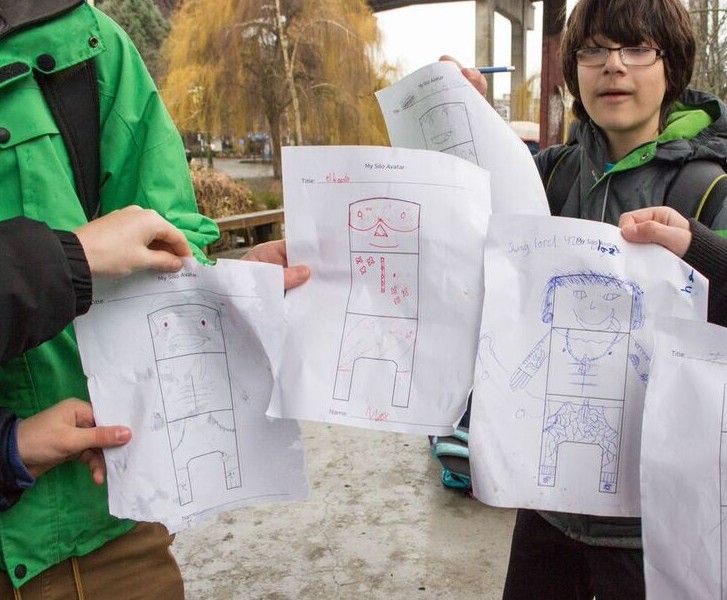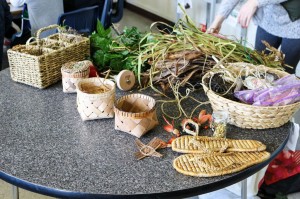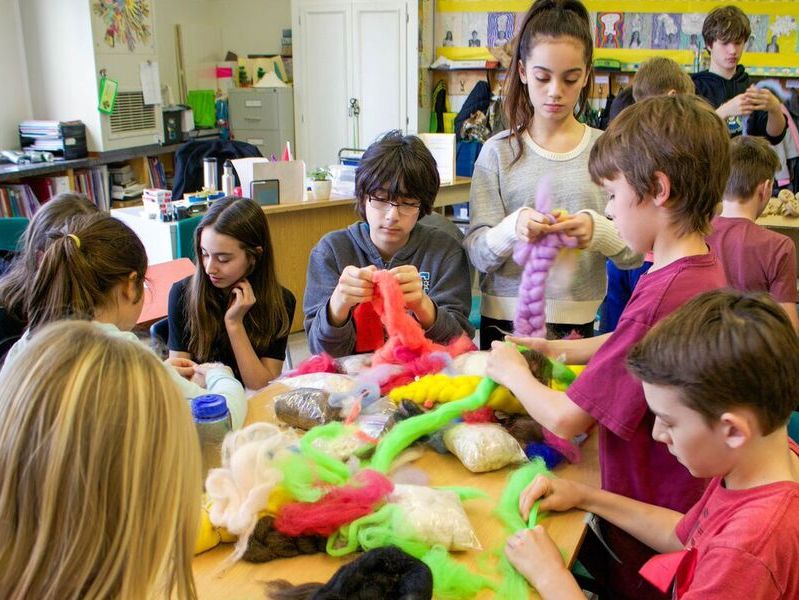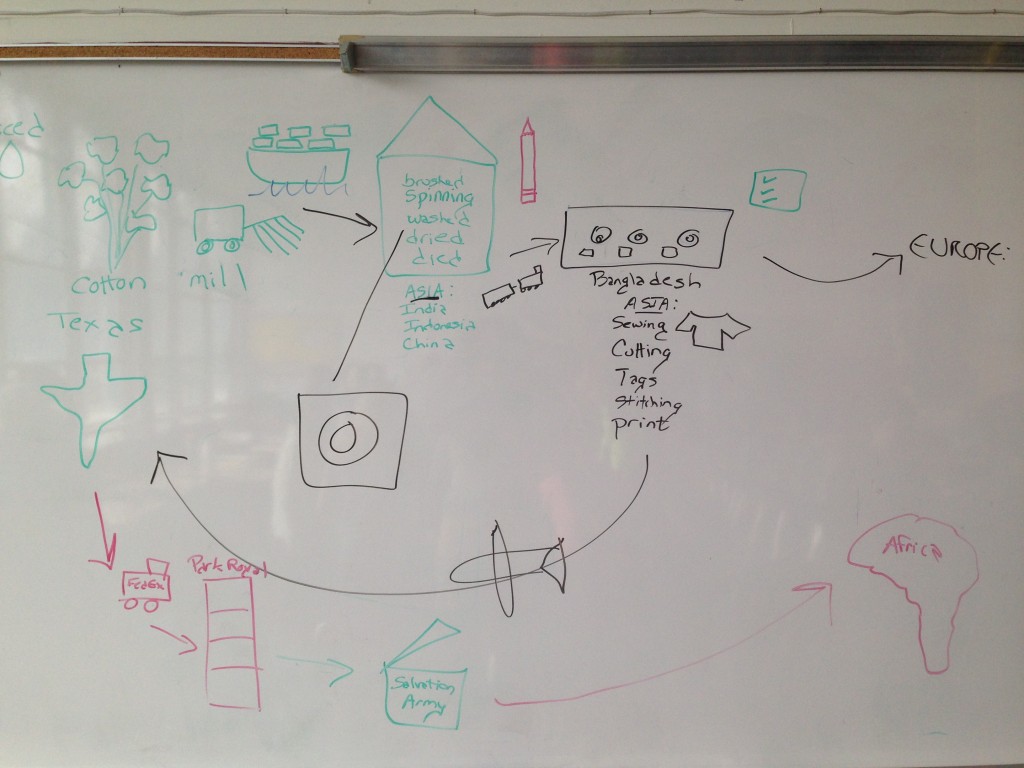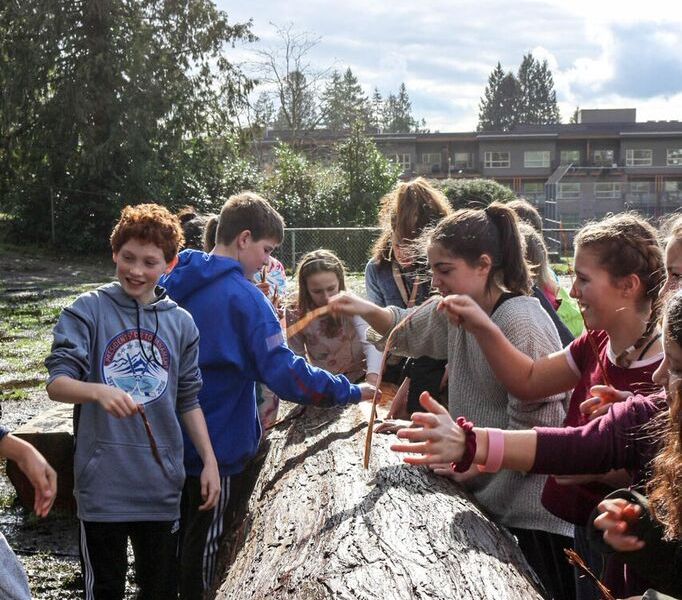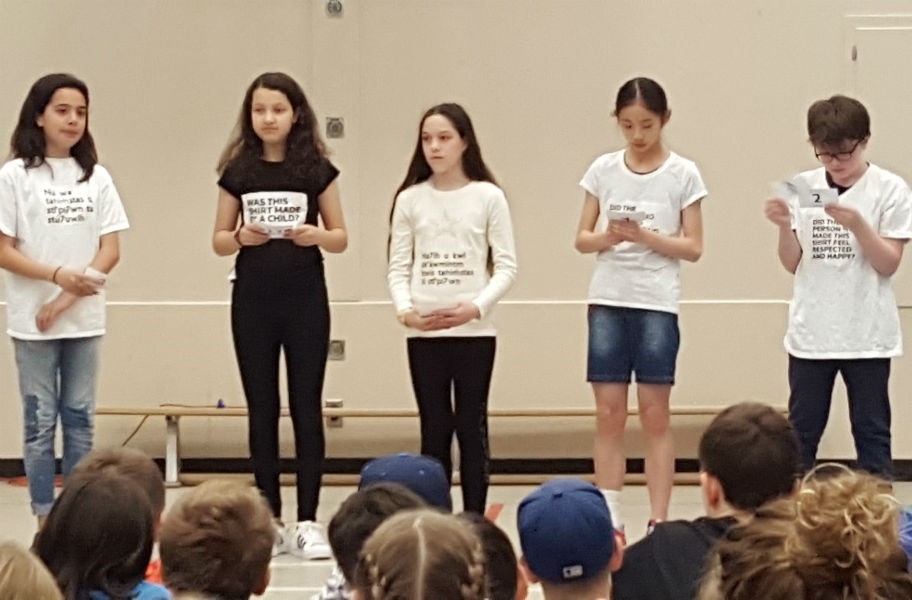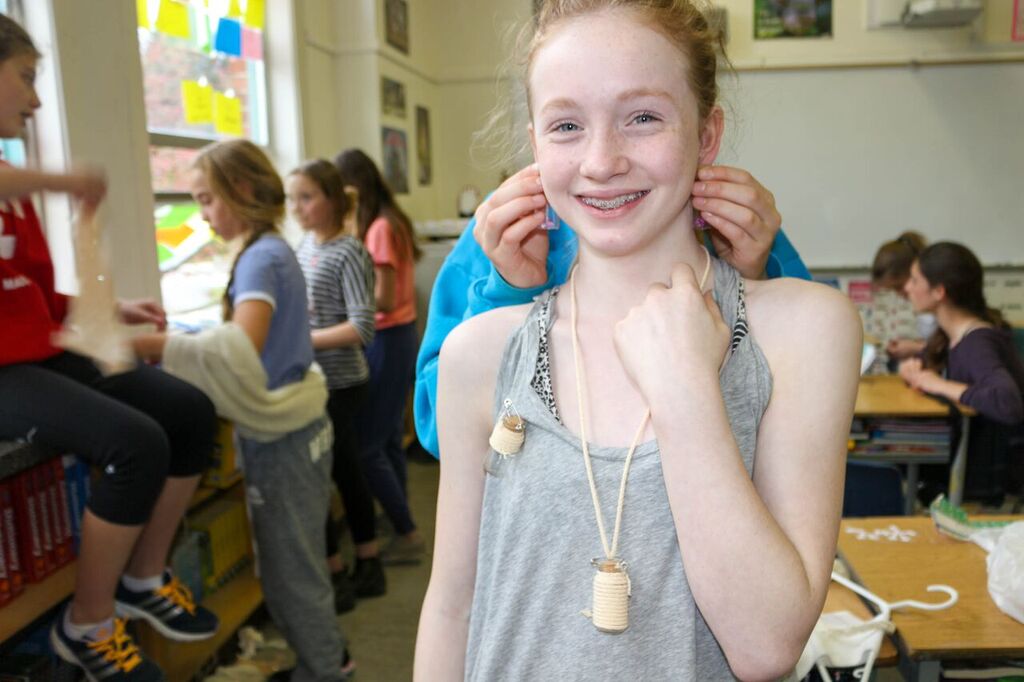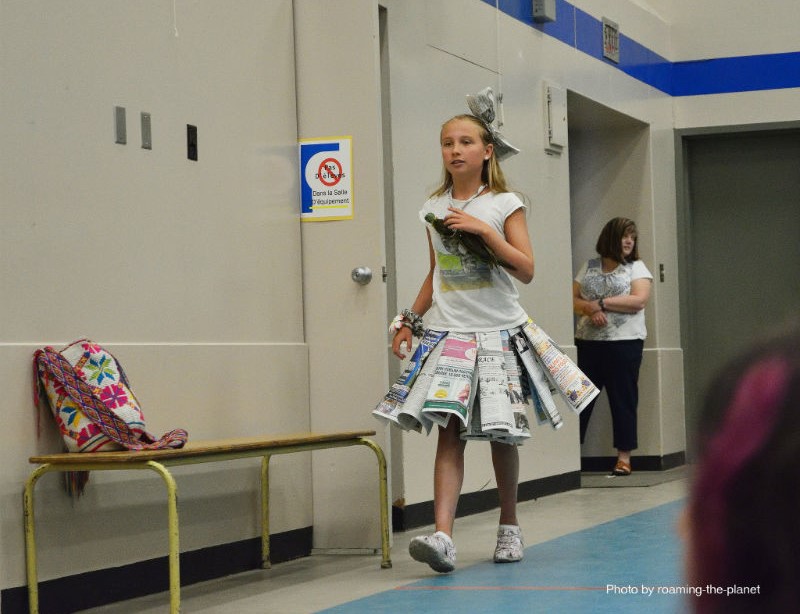École Pauline Johnson – Eye of a Needle
Arts Education, Science, Social Studies
School
École Pauline Johnson, West Vancouver, BC
Teachers
Jennifer Bruemmer, Laura Delasalle, Pascale Powell, and Mahtab Morvarid
Artists
Laura Barron and Juliana Bedoya
Class
Four classes of Grade 6/7
Overview
This international collaboration project, Through the Eye of a Needle brought Vancouver students, from École Pauline Johnson, into conversation with inner city youth from Bogota, Columbia, (in partnership with Liceo Boston), to take a deep look into the relationships between fashion, their self-image, their environment and the history of clothing making (locally and globally). Employing the mediums of music, dance, theatre, visual art and creative writing, artist team, Laura Barron and Juliana Bedoya led students (in Canada and Colombia) through a series of interdisciplinary engagements designed to address these relationships. Through the Eye of a Needle gave students a chance to voice their feelings and ideas related to their individual and cultural identity, peer pressure, consumerism, their connection to local natural materials, as well as to larger global economic realities. At the same time, this inquiry raised their awareness about the resources required to manufacture their clothing. Additionally, by sharing their diverse stories through pen pal communication, these students were able to gain empathy and cross-cultural understanding. Ultimately, out of these explorations emerged a multi-media staged work, using set and costume pieces created from found and available natural materials. This performance was informed by all of the in-class discussions and activities.
Connection to the Vancouver Biennale Exhibition
A field trip to visit the Giants at Granville Island at an early stage in the project provided students the opportunity to launch the discussion about art as a medium for expression. The fact that OSGEMEOS are South American artists and that the Giants are dressed in unique clothing helped build the connection with Liceo Boston, in Bogota and the discussion about the influence of culture on clothing and fashion. During the visit, the students explored through inquiry the link between art and culture. Granville Island provided an excellent opportunity for students to explore and connect with artists of all mediums. They visited the artist studios of the hat maker; silk, felt and hand-dyed clothiers as well as the world instrument shops. In addition, as Granville Island is a tourist center for the city, students took this opportunity to meet and interact with people from different parts of the world.
Other Resources:
- True Cost – documentary film
- The Travels of a T-shirt in the Global Economy, Pietra Rivoli
- Macklemore’s rap song, Wings
BIG IDEAS
Clothing is a universal form of expression that is both individual and collective. For all cultures, our clothing choices also imply much deeper meaning and more complicated implications than meet the eye.
Guiding Questions
How is the clothing that we wear related to our own self-image? How does the clothing we wear impact our global environment and community? How does our global environment and community impact the choices that we make about the clothing that we wear?
Learning Process/Inquiry challenges/Timeline:
This interdisciplinary arts exploration of the true cost of the “Fast Fashion” industry derived its inspiration from the Vancouver Biennale art installation, Giants by OSGEMEOS and the following art inquiry experiences were infused into this project-based learning experience.
WEEK ONE: JAN 19
Classroom engagements began with a movement activity that had students investigating the geographical origins of their clothing. Unpacking whatever information they could glean from their clothing tags, students then placed themselves on a huge floor world map. An inquiry followed, allowing students to consider deeper questions about the origins of their clothing. These insightful students asked everything from “How many accidents were caused by the making of my shirt?”, and “Why are so many items made so far away from where I live?”, to “Did the person who made my shoes feel respected and happy?”
WEEK TWO: JAN 26
90 students from four Grade 6/7 École Pauline Johnson classes visited the Vancouver Biennale public art installation, Giants, by the Brazilian artist twins, OSGEMEOS. The students were inspired how this vibrant installation has truly “dressed up” the otherwise drab concrete silos that loomed over False Creek and radically altering the character of this landscape. The experience served as the perfect launching point for conversations about how students dress themselves to express their own self-images.
After observing the Giants from relatively close up, students discussed the Head/Heart/Hand (in this case Foot) qualities expressed by the colorfully imaginative patterns painted on the silo characters. Correspondingly, they were asked what the artistic characters’ clothing makes them Think and Feel, and what it says about the activities that the character might like to Do. Then, the students inverted these questions towards themselves, building vocabulary around how they want their wardrobe choices to make people Feel; what they want people to Think about them based on their clothing/accessories, and what their outfits say about what they love to Do. Using these descriptors, they were then invited to design their own personal Silo Avatars, (in the shape of The Giants), complete with patterned clothing, accessories and footwear, if they so chose.
The students then visited four shops on Granville Island, Maiwa Prints, Dream, Make Store, and Ten Thousand Villages, that relate to the project inquiry of natural fibres, locally made clothing, and up cycling. Using all of their senses, the students proceeded to scavenge for clues related to the project theme by feeling, seeing and hearing their way through the stores. They explored the following prompting questions: How many items can you find that are woven? Can you list up to ten items that have been made by repurposing other materials? List 4 animal and 4 plant fibres that you can find in this store? What is the name of a natural dye made from a bug, used in this store? Find 3 items made by a local designers.
WEEK THREE: FEB 2
In class artist Juliana Bedoya opened with an acknowledgement of traditional territory by recognizing the First Nations peoples of British Columbia as traditional stewards of the land. She then allowed students to interact with a variety of plant and animal fibers: flax, bamboo, silk, cotton, wool – sheep, mountain goat and even dog – stinging nettle, bull kelp, cedar bark, and Himalayan blackberry. This led into an introduction of ancestral fabric-making technologies, as well as a discussion about the pace of the human body vs. industrial ways. Students then used handmade whorl spindles and drum carders to spin their own flax and wool into yarn, with which they eventually produced their own fabric pieces. Students were asked to consider the category of clothing that they use to most express themselves (choosing from Tops, Bottoms, Accessories, or Footwear). Their responses then determined which fabric name tag they would make and wear for the duration of our project.
During the workshop session ran in parallel by artist Laura Barron, students were asked to imagine the full global Journey of a T-Shirt (from seed to rack) creating a graphical recording the students ideas. Since the students were very well informed by the documentary The True Cost, which were viewed prior to the start of the arts engagements, they accurately articulated the massive carbon footprint (16,000+ miles) of this many layered, labor intensive process. During the workshop session, the students uncovered many t-shirts’ often ends up in a variety of underdeveloped countries, in Africa, South America, or ironically back in Asia in the final phase of their life. The students were exposed to the common practice known as mitumba, where clothes intended for donation in wealthier countries are re-purchased, shipped abroad and then sold cheaply to people in poorer regions. The practice has received heavy criticism for its impact on local textile industries, and for its environmental cost.
Students listened to a spectrum of soundscapes related to this journey (cotton mill, sewing factory, washing machine, pencil scribbling in a design studio, cash registers) and formed small groups to act out these imagined scenes along the journey, as collaborative Human Machines. Each group were given 2 character portrait templates to brainstorm the Head/Heart/Hand qualities of the people who work in each phase of the t-shirt journey including cotton farmer, factory boss, American designer, etc.. These characters would eventually weaved into an original play that the students co-create, expressing whichever injustices of the fast fashion world they feel and most moved to change.
WEEK FOUR: FEB 9
The students got to work with a variety of plant materials used by the Coast Salish people to make their clothing from ancestral technologies. Along with their own hands-on experiences related to clothing making, students continued to explore the Global Journey of the T-shirt. Examining this often problematic journey, students identified problems related to human rights, the environment, and the economy, in order to determine the “wrongs” they wanted to “right’ in their own original play about this important topic. Consumer greed, excessive transportation covering 16,000 global miles from seed to rack, CO2 emissions, unfair labor laws, unequal and insufficient wages, unsafe work environments, and toxic chemicals used in the agricultural and manufacturing processes were some of the grave problems that they have identified. The students engaged in story yarn activities to spark their imagination on how to resolve these rather massive global problems.
WEEK FIVE: FEB 16
Week Five expanded upon all of the visual and theatrical arts activities of the previous week. Artist Juliana Bedoya immersed students deeper into the process of sourcing natural materials for fibre by taking them into their own school yard to explore what was available in their backyard. Students explored blackberry vine as Juliana Bedoya demonstrated how to interact with this plant material.
During their writing workshop session, the students delved further into their story weaving, by engaging in Character Development activities, in small groups. Artist Laura Barron introduced a relevant traditional Hans Christian Andersen fairy tale called The Wild Swan, about a princess who could only save her 11 brothers from being eternally transformed into swans, by weaving them sweaters out of stinging nettle (a local BC plant also used for clothing making in ancient times).
Examining the Anatomy of a Fairy Tale (complete with magical animals and helpers; good and evil characters; and transformative natural materials) students then brainstormed about their own solutions to the problems that they identified along the global journey of the t-shirt. Their unique creativity rendered some of the most brilliant and sophisticated ideas. The following is a sample of some of their imaginative solutions, many of which align directly with sound economic principals, adopted by many progressive global businesses:
1. The students suggested a “profit sharing” model, accomplished by magic Phoenix birds flying half of the money made at the retail stores back to the people who manufactured the clothing in Bangladesh.
2. For a “sustainable currency”, the students decided that the clothing corporations should plant apple farms and then harvest the seeds as an alternative currency to dollars. This way, everyone along the ‘fast fashion’ supply chain could re-plant their seeds to create more money as needed. Students also determined that the intention was not for everyone to get rich, but rather to simply harvest “just enough” seeds to cover their basic needs: food, shelter, clothing, and clean water.
3. The students developed a customer service model much like “business process integration” (a fancy term for an efficient manufacturing and distribution strategy, now implemented by companies worldwide). The idea was to limit each customer to a 4-outfit-per-year quota, which they would pre-order (in advance of fabric & clothing production, to avoid waste). Then, each person would have their own personal-order dragon to deliver their order to workers along the supply chain. And finally, this dragon would return their items to them directly (eliminating inefficiencies in the delivery system).
4. For an “alternative transit” solution, the students invented magical flying chopsticks that could transport all of the materials around the globe, as needed for the t-shirt journey, “emissions-free”.
5. The students created “fair labor legislation” by placing a secret playbook, hidden amongst the sewing machines, for a Bangladeshi factory worker to discover. This brave employee, then privy to all of the fair labor practices that their bosses should observe, spoke up for her colleagues and insisted that the book’s laws be enforced.
6. Devising an “organic farming” alternative, the students imagined fairies who could spread magical chemical-free crop dust on the cotton so that this essential plant would receive all of the water and nutrients that it needed to source the clothing industry in an environmentally friendly way.
WEEK SIX: FEB 23
The students, through their art inquiry activities with Juliana Bedoya, have now gained a deepened appreciation for the sustainability of ancestral clothing making technologies using natural and plant-sourced materials. After being introduced to these varied weaving materials (blackberry vine, ivy, cedar bark, & hand-spun wool), Juliana invited students to begin creating wearable accessories to gift to their Colombian peers. The students were given the opportunity to let their imaginations run wild, like the very plants they were handling.
With Laura, students continued to dig deeper into personal questions related to their own fashion choices. First they listened to Macklemore’s very relevant rap song, Wings, which tells the horrific tale of a young boy who ends up murdered over a pair of sneakers. Students carefully analyzed the lyrics of this powerful song condemning brand dependency, and whose final verse conveys an important message that resonated with many of the students:
What I wore, this is the source of my youth
This dream that they sold to you
For a hundred dollars and some change
Consumption is in the veins
And now I see it’s just another pair of shoes
Following their discussion about this thought-provoking music, Laura Barron led an inquiry intended to inform original rap songs that the students would create about these same concepts. They were asked to prioritize which elements most influenced their own clothing choices: Look? Self-Image? Peer Pressure? Ads? Price? Brand? Fit? Fabric? Social Responsibility of brand? Choosing from the same list, the students answered the question: “It bothers me when people care too much about _________________?” The prevailing responses showed Peer Pressure, Price, Brand, & Self-Image to be the influential issues of greatest concern and defined the themes that they would explore musically, in the following session.
WEEK SEVEN: MARCH 8
To warm-up students’ voices, rhyming and rhythmic skills, Laura Barron introduced the students to her original Moose Juice activity, which is an adaptation of a nursery rhyme, set to a hip hop backing track, over which students invented their own rapped verses about animals doing different rhyming activities (a bear washing his hair; a parrot eating a carrot, etc.). Then, the class split into four groups, each aligned with one of the four selected topics: Peer Pressure, Price, Brand, & Self-Image, and began brainstorming theme words related to their topic. To build vocabulary for their raps, the students then compiled Rhyme Banks of assonant words (cost/lost/frost; cool/school/rule, etc.). Finally, the students had a blast collaboratively writing 1-4 verses, each, about their topic, using the emphatic and expressive medium of rap to deliver strong messages about the issues that concerned them.
Juliana’s seventh session had the students involved in a hub of visually artistic activity. Following up from the previous week’s weaving activities, students brought to class completed fibre gifts for their Colombian peers. The range of mediums with which they had to play, inspired an array of colorful creations, including necklace charms, bracelets, and belts for their new friends.
Additionally, as an evolution of the first week’s clothing tag inquiry, students chose the questions that most resonated with them to render onto their own re-used t-shirts. Each statement was expressed in either English, French, Spanish, or Squamish – appropriately representing the official language of their French immersion school, that of their Colombian collaborators, and the mother tongue of the local First Nations people whose ancient fibre technologies they have been exploring. The simple iron-on decals produced beautiful results, and these become unified “costumes” that all of the students can wear to perform their final fairy tales and raps.
The students then reconnect to the descriptive personal adjectives that they identified on their Granville Island field trip, during Week Two, for their personal silo avatars, allowing these to inspire fashion creations that could reflect their individual identities. In this process, students considered their potential available materials (natural fibres, used fabrics, and found or reclaimed “trash” materials such as newspaper, garbage bags, plastic bottles, straws, and more), as well as the practical “do ability” of their design, given only two remaining class periods to fabric their final pieces. And students used the remainder of the period, to sketch their concepts.
WEEK EIGHT & NINE: March 29 & April 12 – From Sowing to Sewing
Finally, the exciting global exchange component of this project was initiated in a Skype chat held over recess, between 12 select Pauline Johnson students and all of the Grade 8 students at Liceo Boston with whom Juliana and Laura will work in May. The West Vancouver students shared some of their insights and creative products with the Colombian students and displaying many of the fashion pieces. Then, they had an opportunity to ask some burring questions of their peers in Bogota. An interesting discussion ensued about the pros and cons of wearing school uniforms (as the Liceo Boston students do). And a good portion of the students’ curiosity revolved around James Rodriquez & Radamal Falcao, two Colombian soccer (futbol) superstars whom the Pauline Johnson students follow on their Real Madrid and Manchester United teams. Perhaps overshadowing these students’ shared purpose in our fast fashion project was the thrilling fact that a particularly talented young soccer player from Liceo Boston happened to be connected to one these stars on What’s App? !! Maybe the Whitecaps will even luck out, one day, and score one of these South American sensations.
More details about this project: Something Collective Blog
Cross-Curricular Access
Science, Social Studies, Art and Language Arts curriculum were used throughout as outlined in the previously mentioned lessons. The new draft curriculum for these four areas was applied to the BIG IDEAS project.
- Arts Education: A visit to the Giants urban mural and other sites on Granville Island relevant to the fashion and textile industry (Funk Shui felt clothing; Maiwa Handprints for naturally dyed clothing; Inkary for Alpaca woold clothing)
- Social Studies: Using films and books as project references to raise students’ awareness about the resources required to manufacture their clothing.
- Economic & Business Education: Students to create an original song about their discoveries throughout these engagements exploring questions related to the economic and environmental impact of the fashion industry.
- Arts Education: Explore issues of self-image through a theatrical presentation of their learning which incorporates music and movement and costume design.
- Science: Study of wild animal and vegetable fibres like wool, linen, silk, cotton and the different ways they have been processed from ancestral times in the cultural context of both schools (Northwest Coast and Colombian Aboriginal peoples).
- Science & Social Studies: Understanding fibres from pre-industrial and post-industrial contexts through hands on experience on how to use a drop spindle.
- History & Social Studies: Explore the history of clothing-making industry through weaving, and natural/found object fabrication activities to create costumes and set pieces for the performance.
Reflection
Artists – Laura Barron and Juliana Bedoya
Since January, Pauline Johnson students have been immersed in a multi-layered exploration of the fast fashion industry. This project has challenged their critical thinking while developing their skills as designers, weavers, textile artists, playwrights, rappers, and performers. And now, months of seeding, sowing and cultivating have bloomed into a variety of creative products. Throughout this project, these youth were asked to take a “YES, AND…” attitude towards many new or unfamiliar modes of expression. And while, understandably, there was occasional resistance, they ultimately rose to the challenge with a willing, cooperative spirit. Consequently, their work reflects a wide range of student interests, concerns and visions for a more sustainable and healthy fashion industry. Their performative work has required a considerably rapid creation and preparation process. The project results in 90 students created 10 original raps and 9 unique skits.
Adding to the usual 3 R’s, Reading, wRiting, and aRithmetic, Through the Eye of Needle has emphasized the importance of Repurposing, Recycling and Reimagining. Consequently, one of the major take-aways from these artistic engagements has been the understanding that a myriad of resources, materials and gifts are available to us in our immediate environment and community with which great beauty can be created. With their heads, hearts and hands, these students have contributed their complimentary strengths to a rich body of performative work. They have also harvested native plants, scavenged for natural materials, and gathered fabric scraps, newspaper, garbage bags, ropes, bottles, ducktape and sand to invent a full runway of clothing items ranging from pret-a-porter to haute couture. So, watch out Ralph Lauren! Here come the next generation of designers.
Students Reflection
“I now know not to buy my clothes at a cheap place. You changed my perspective of the world and I will always remember that, so thank you”
”I hope the Colombian kids will have the same amount of fun that I had!”
“Thank you so much for teaching us about the materials and fabrics that are used in clothing and that were used a while ago on the Coast Salish lands. I am so much more aware of the nature around me and how if you harvest it the right way you can use techniques to make clothing.”
“You’ve taught me so much information about our clothing which has given me a different look on how I buy my clothes. You were always so positive with our classes (even if you wanted to get mad!).”
”Not only did you teach us more about he fashion industry but you also taught us that our economy needs to change, and as the next generation it is our job to change it.”
“Thank you for acknowledging that we stand upon Coast Salish Territory, and for teaching us ancient ways of making clothes.”
“Next time I’ll think before buying a t-shirt.”
“Thank you for spending your time to teach us things and have fun at the same time.”
“Thank you for teaching us about how people are influenced by their peers, the price, and other aspects when choosing clothes. I learned a lot and those are things I will definitely think about in the future.”
“Thank you for giving me the chance to be narrator in a play I help create.”
